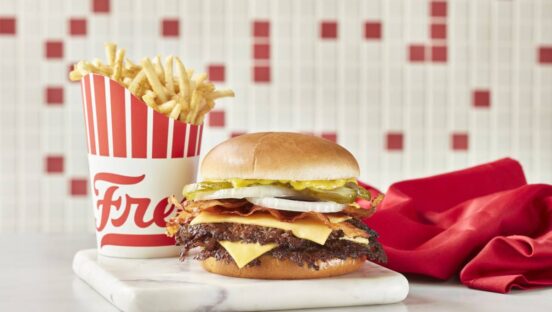There was a real person behind the name Freddy’s Frozen Custard & Steakburgers. He was a man who grew up in Wichita, Kansas, enlisted in the Army, and came back a war hero with a Purple Heart and Bronze Star Medal.
After serving his country, Freddy Simon entered the hospitality business, meaning his entire adult life was in the business of serving others, said Freddy’s CEO Chris Dull.
“Everything we do at Freddy’s, we try to think about how Freddy would do it,” Dull said. “What would his generation feel about how we’re taking on this new initiative because it’s very important to us that we maintain doing things in Freddy’s way.”
The philosophy involves three pillars, starting with made-to-order products that aren’t slapped in a clamshell grill and handed over the counter or drive-thru window. However, that elevated quality doesn’t equate to long wait times. Freddy’s operates an assembly line–style kitchen that’s quite fast for made-to-order menu items; the chain cooks its smash burgers in less than one minute and 30 seconds. According to Dull, cleanliness is the second pillar that makes the brand special. He views it as the cost of entry into the restaurant space.
The third and most important part is hospitality, which is about “trying to create special, one-of-a-kind moments in the lives of our guests,” Dull said. The chain does this well with an 85-plus percent guest satisfaction score.
“Genuine hospitality goes beyond a canned response and a smile. It’s taking the extra step,” Dull said. “It’s helping someone to the car with their food. It’s someone who has a spill that you see in drive-thru when you come around and you bring them a new beverage and plenty of towels and you go over the top to make sure that they feel like they were touched and they were acknowledged and that this was something above and beyond.”
Adhering to these principles pushed Freddy’s to 518 units as of January, consisting of 95 percent franchisees. There are more than 550 restaurant development commitments, and over 140 locations are either under construction, purchased land, or signed leases. AUV was $2 million in 2023, up from roughly $1.6 million in 2019, and adjusted EBITDA was around $38 million. Last year the brand earned $928 million in systemwide sales, and it projects $975 million in 2024.
Existing franchisees represent 90 percent of the 550-plus committed stores and the 140-plus units under development. Roughly 40 percent of Freddy’s 65 operator groups own over five locations, followed by 36 percent with two to five outlets. The fast casual offers deals to new operators between three and seven restaurants. It will consider double that amount if the restaurateur is well-capitalized.
Freddy’s hopes to open about 65 stores in 2024 after debuting 62 restaurants last year. That’ll come with little to no closures as the brand has only shuttered 22 units in its 22-year history. That calculates to a 96 percent success rate for every Freddy’s location that’s opened. The company believes it has enough whitespace for 3,000-plus restaurants in existing and new markets across North America. Its biggest footprints are in Texas, Oklahoma, Missouri, Nebraska, and Colorado.
Dull said the chain competes with both the value and better burger categories.
“You’ll be shocked to see that we’re in 36 states and really the only better burger that goes coast to coast,” he said. “We compete with In-N-Out on the western side of the U.S. We compete with Whataburger throughout Texas in the middle of the U.S. We compete with Five Guys in the East, and we compete with Culver’s in the North. But those guys don’t all compete with each other. Really the Northeast is the last frontier for us, but we’re coming.”
Burgers account for 63 percent of sales. After that it’s custard (15 percent), chicken (9 percent), kids meals (5 percent), hot dogs (4 percent), and individual side items (4 percent). Freddy’s will work in 2024 to boost its chicken offering, a category in which it grossly under-indexes, Dull said.
Off-premises mixes 68 percent compared to 32 percent dine-in, which is a complete flip from pre-COVID times. Of those sales outside the four walls, 51 percent come via drive-thru, 10 percent carryout, and 7 percent third-party delivery. Forty percent of guests arrive at dinner, 32 percent come at lunch, and 28 percent order in the afternoon or late evening.
Dull became CEO after his company Thompson Street Capital Partners purchased Freddy’s in 2021. One of the major investments his team made when entering the chain was completely gutting and rebuilding the digital stack, from the POS system to the web and app ordering platforms. The group has increased loyalty membership from 100,000 to 1.6 million since mid-2022. This is helpful to margins since loyalty members have a 15 percent higher average ticket. Thompson Street Capital also implemented several operational improvements, such as switching from four cup sizes and five or six lids to three cup sizes and three lids. This alone saved approximately $3.5 million for the franchise system. Additionally, the company launched a new grill press that’s easier for employees to learn.
Currently, Freddy’s collects 1.5 percent of the 3 percent marketing support fund, so Dull sees an upside to building awareness around the business.
“We haven’t been talking about the brand at all until 2021, and we’re still whispering. So we have an opportunity to really start to sing from the hilltops,” Dull said. “And over time, we will take on more of the fund and be doing a lot more work out there to spread the good word.”
Thirty-five percent of Freddy’s customers have a household income of $50,000–$100,000. That’s followed by over $100,000 (31 percent), $25,000–$49,000 (22 percent), and under $25,000 (9 percent). Forty-five percent are millennials, 26 percent are Gen X, 15 percent are Gen Z, and 14 percent are baby boomers.








